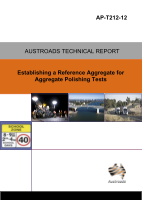Pavement

- Publication no: AP-T212-12
- ISBN: 978-1-921991-53-0
- Published: 23 October 2012
- PDF (free) Download
Polished aggregate friction value (PAFV) tests are used by most jurisdictions in Australia to determine the resistance of aggregates to the polishing action of vehicle tyres on the road. Two versions of the PAFV test are used in Australia: the vertical PAFV test and the horizontal PAFV test. Stocks of the current reference aggregate are almost depleted. Studies were conducted using the vertical PAFV test method to investigate the relationship between unpolished and polished friction values obtained for two different types of aggregate, and the effects on polishing results caused by the use of different aggregate polishing grit feed rates and different aggregate polishing grit types. A proficiency study, involving seven different laboratories, was conducted in order to assign PAFV friction values to the identified replacement reference aggregate for PAFV tests ‘UK aggregate’.
- 1. introduction
- 2. EXPERIMENTAL DESIGN
- 2.1. Aggregates
- 2.2. Aggregate Polishing Tests Performed at the ARRB Laboratory
- 2.3. Sample Treatment Procedures Used in the Proficiency Study
- 3. RESULTS AND DISCUSSION
- 3.1. Friction Test Studies Conducted at the ARRB Laboratory
- 3.1.1. Investigations into the Relationship Between Unpolished and Polished Friction Values
- 3.1.2. Effects of the Use of Different Abrasive Grits in the Vertical PAFV Test
- 3.1.3. Effects of Abrasive Grit Feed Rate on Vertical PAFV Test Results
- 3.2. Proficiency Study Results
- 3.2.1. Choice of the Type of UK Aggregate Used in the Proficiency Study
- 3.2.2. Proficiency Study Participants
- 3.2.3. Proficiency Study Experimental Results
- 3.2.4. Comparison of Proficiency Results for Vertical and Horizontal PAFV Tests
- 3.2.5. Analysis of Proficiency Study Results
- 4. CONCLUSIONS
- References
